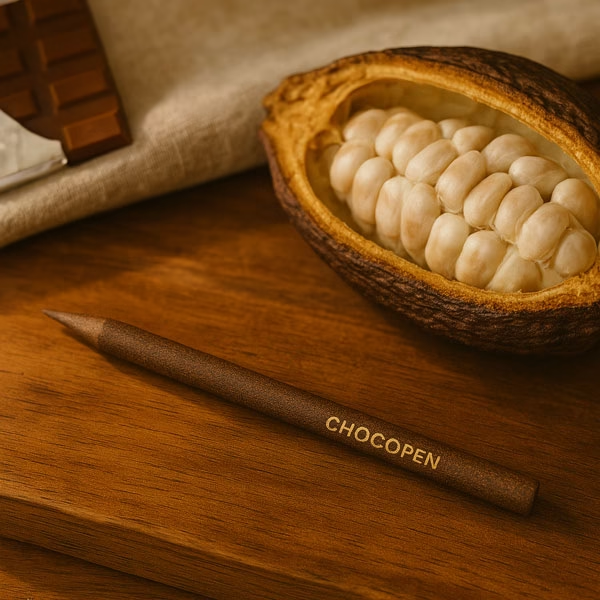はじめに:CHOCOPENとは?- チョコレートから生まれた、地球と人にやさしい鉛筆
こんにちは!
仕事の合間や、ちょっと一息つきたい時。甘いチョコレートって、心をほっと癒してくれますよね。私もついつい、デスクの引き出しに忍ばせています。
でも、もしそのチョコレートを作る過程で、たくさんの「ごみ」が生まれているとしたら…?そして、その「ごみ」が、遠い国の環境や人々の健康を脅かしているとしたら、少しだけ胸がチクッとしませんか。
「なにか自分にもできることはないかな」
「でも、大それたことは難しいし…」
そんな風に感じる、やさしいあなたにこそ知ってほしい一本の鉛筆があるんです。
それが、今回ご紹介する「CHOCOPEN(チョコペン)」。
この鉛筆、ただの鉛筆じゃないんです。
なんと、私たちが大好きなチョコレートの原料である「カカオ」。その実から豆を取り出した後に残る「カカオの殻(カカオハスク)」から作られているんですよ。
本来であれば、その多くが捨てられてしまうはずだったもの。
それが、日本の老舗文具メーカー「三菱鉛筆」の技術と、アフリカ・ガーナで支援活動を行う「NPO法人CLOUDY(クラウディ)」の熱い想いが出会って、こんなに素敵な鉛筆に生まれ変わりました。
しかも、このCHOCOPENには、もっと心温まるストーリーが隠されています。
それは、「あなたが1本買うと、ガーナの子どもたちにも1本届く」というチャリティの仕組み。
この記事では、
- CHOCOPENが生まれた背景にある、チョコレートの裏側の物語
- 私たちがCHOCOPENを選ぶことで、どうやって社会貢献に繋がるのか
- 前例のない鉛筆が完成するまでの、開発の裏側
- 気になるデザインや価格、どこで手に入るのか
など、CHOCOPENの魅力をあますところなく、たっぷりとご紹介していきます。
読み終わる頃にはきっと、この小さな一本の鉛筆が、とても愛おしく感じられるはず。
私たちの「選ぶ」という小さなアクションが、世界をちょっと良くする大きな一歩になる。そんな素敵な物語を、一緒に紐解いていきませんか?
なぜカカオの殻?CHOCOPENが解決するガーナの社会問題
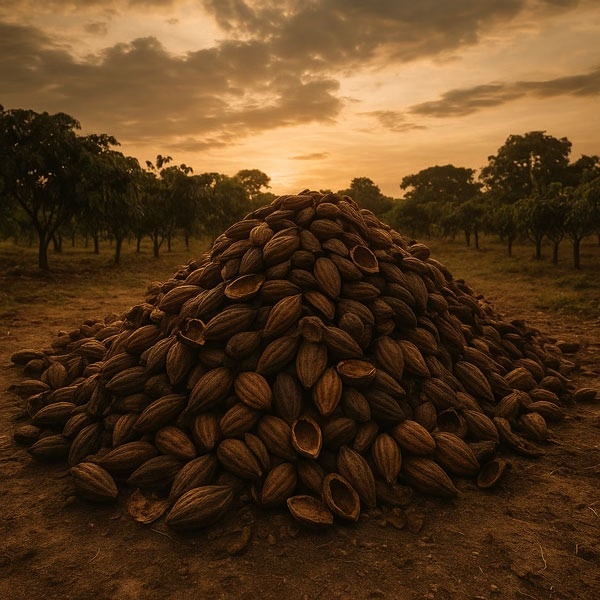
「カカオの殻から鉛筆を作るなんて、面白いアイデア!」
そう感じますよね。でも、このプロジェクトが始まったきっかけは、実はもっと深刻な問題意識からでした。
まずは、CHOCOPENが解決しようとしている、アフリカ・ガーナの社会問題について、少しだけお話しさせてください。
チョコレートの裏側にある課題:大量に廃棄されるカカオの殻
日本の私たちにとって、ガーナといえば「ガーナチョコレート」を思い浮かべる方も多いのではないでしょうか。そのイメージ通り、ガーナは世界有数のカカオ生産国。カカオ産業は、国の経済を支えるとても重要な柱です。
でも、その裏側で、長年にわたって大きな問題となっていたのが、収穫後に残る大量の「カカオの殻」の存在でした。
チョコレートの原料になるのは、カカオの実の中にある「カカオ豆」という部分だけ。実は、カカオの実の重さの約90%は、この殻やわた(パルプ)など、豆以外の部分なんです。つまり、私たちが100gのチョコレートを食べるためには、その裏で1kg近い殻が生まれている、なんて言われることもあるくらい。
カカオ豆の生産量は世界で年間約500万トンにも上ると言われていますから、その何倍もの量の殻が毎年生まれていると考えると、ものすごい量だということが想像できますよね。
農家さんたちは、この大量の殻の処理にずっと頭を悩ませてきました。
一部は肥料として再利用されることもありますが、そのほとんどは畑の脇や村のあちこちに野積みされています。
そして、この野積みされた殻が、さまざまな問題を引き起こしてしまうんです。
カカオ殻が引き起こす、環境と健康の問題点
| 問題点 | 具体的な内容 |
| 土壌汚染 | カカオの殻は酸性度が高く、大量に放置されると土の性質を変えてしまい、他の作物が育ちにくくなる「土壌汚染」の原因になります。カカオ農家さん自身の畑が、元気をなくしてしまうなんて、悲しいですよね。 |
| 害虫の発生 | 殻が腐敗する過程で、農作物に害を及ぼす虫が発生しやすくなります。 |
| 悪臭の問題 | 大量の殻が腐ることで、強いにおいが発生し、村の生活環境を悪化させます。 |
| マラリア蚊の発生 | これが最も深刻な問題の一つです。カカオの殻のくぼみには雨水がたまりやすく、それが感染症「マラリア」を媒介する蚊の絶好の繁殖場所になってしまうんです。 |
特に、マラリアの問題はとても深刻です。
世界保健機関(WHO)の報告によると、ガーナは世界で最もマラリアの疾病負担が大きい11カ国のうちの1つ。2022年には、約530万人の感染者と、約1万2500人の死亡者が報告されています。
その多くは、抵抗力の弱い5歳未満の子どもたちだと言われています。
自分たちが食べるチョコレートのために、遠い国の子どもたちが危険にさらされているかもしれない。そう考えると、とても人ごととは思えませんよね。
「ごみ」を「資源」に:CHOCOPENがもたらす変化
「このやっかいものとされてきたカカオの殻を、なんとか価値あるものに変えられないだろうか?」
この想いからスタートしたのが、CHOCOPENのプロジェクトです。
最近よく耳にする「アップサイクル」という言葉をご存知ですか?
これは、単に再利用する「リサイクル」とは少し違って、捨てられるはずだったものに、デザインやアイデアといった新しい価値を与えて、もっと素敵なものに生まれ変わらせる取り組みのことです。
CHOCOPENは、まさにこのアップサイクルの考え方そのもの。
これまで「ごみ」として扱われ、環境や健康の問題を引き起こしていたカカオの殻を、「鉛筆」という全く新しい価値を持つ製品へと生まれ変わらせたのです。
このプロジェクトが素晴らしいのは、それだけではありません。
鉛筆の製造工場をガーナ国内に建設したことで、現地に新たな「雇用」を生み出しました。農家さんたちは、これまで捨てていた殻を工場に売ることで収入を得ることができ、工場で働く人々は、安定した仕事を得ることができます。
つまり、CHOCOPENは、
- 環境問題を解決する(ごみの削減、マラリア蚊の繁殖地抑制)
- 新たな産業と雇用を生み出す(経済的な自立を支援)
という、2つの大きな変化をガーナにもたらしているんです。
「FOR MY BUDDY」- あなたの購入が、ガーナの未来を描く
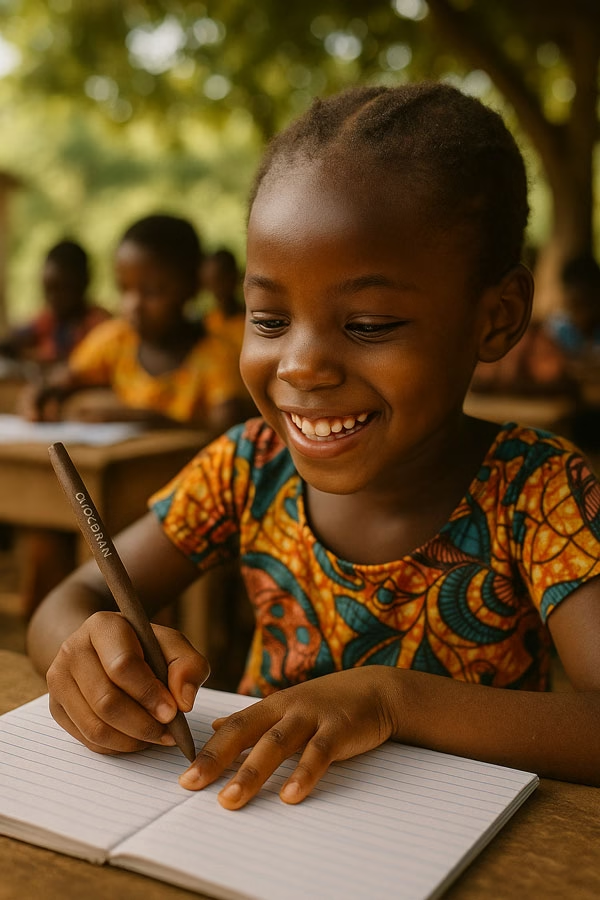
CHOCOPENの魅力は、環境や経済への貢献だけにとどまりません。
この鉛筆には、私たち一人ひとりの「買う」という行為が、もっと直接的にガーナの子どもたちの未来に繋がる、心温まる仕組みが隠されているんです。
CHOCOPENのユニークなチャリティ
CHOCOPENのパッケージを、ぜひじっくりと見てみてください。
なんだか不思議な形をしていませんか?
鉛筆が2本収まりそうな筒状のケースなのに、中に入っているのは1本だけ。
そして、空いている方のスペースには、こんなメッセージが書かれています。
「FOR MY BUDDY」
BUDDY(バディ)とは、「相棒」や「仲間」という意味。
そう、この空いたスペースは、あなたの「相棒」であるガーナの子どものための場所なんです。
私たちがCHOCOPENを1本購入すると、もう1本がガーナの子どもたちの元へ届けられる。
このパッケージは、その約束の証。手にした瞬間、遠い国の見えない「相棒」との繋がりを感じさせてくれる、とっても素敵なデザインですよね。
「なぜ、文房具の寄付なの?」と疑問に思うかもしれませんね。
NPO法人CLOUDYが活動するガーナでは、経済的な理由から、学校に通えても文房具を十分に揃えられない子どもたちがたくさんいます。ノートや鉛筆がないために、授業の内容を書き留められなかったり、読み書きの練習ができなかったり…。勉強したくても、そのための道具がない、という状況なんです。
鉛筆一本。
それは、私たちにとっては当たり前に手に入るものかもしれません。
でも、ガーナの子どもたちにとっては、自分の夢を描き、未来を切り拓くための、かけがえのない「翼」になりうるのです。
私たちがCHOCOPENを選ぶという、たった一つのアクション。
それが、地球の裏側にいる「相棒」の学びに繋がり、その子の未来を明るく照らす光になるかもしれない。そう思うと、なんだか胸が熱くなりませんか?
持続可能な支援の形
「寄付」と聞くと、単純に物資を送るだけのイメージがあるかもしれません。
もちろんそれも尊い支援ですが、CHOCOPENの仕組みがさらに一歩進んでいるのは、それが「持続可能な支援」のモデルになっている点です。
有名な言葉に、「お腹を空かせた人に、魚を一度与えれば一日の飢えをしのげる。だが、魚の釣り方を教えれば、一生飢えることはない」というものがありますよね。
CHOCOPENのプロジェクトは、まさにこの考え方を体現しています。
- ガーナ国内で、ガーナの資源(カカオ殻)を使って
- ガーナの人々の手によって鉛筆を作り(雇用創出)
- その利益の一部で、ガーナの子どもたちの教育を支援する
というサイクルを生み出しているのです。
外部からの支援に頼り続けるのではなく、現地の人々が自分たちの力で問題を解決し、経済を回し、未来を育んでいく。
CHOCOPENは、そんな「自立」への道を一緒に作っていくプロジェクトなんですね。
私たちが支払う330円には、単なる商品の対価だけでなく、こうした持続可能な未来への投資という意味も込められている。そう考えると、この一本の鉛筆が、より一層価値あるものに感じられます。
開発秘話:困難を乗り越えて。三菱鉛筆の技術とCLOUDYの情熱
こんなにも素敵なストーリーを持つCHOCOPENですが、その誕生までの道のりは、決して平坦なものではありませんでした。
「カカオの殻で鉛筆を作る」という前例のない挑戦には、たくさんの困難が待ち受けていたのです。
ここでは、CHOCOPENが私たちの手元に届くまでの、開発の裏側を少し覗いてみましょう。
プロジェクトの始動
この物語の始まりは、二人の人物の出会いでした。
一人は、NPO法人CLOUDYの代表理事を務める、銅冶勇人(どうや ゆうと)さん。
大学在学中に訪れたアフリカの現状に衝撃を受け、卒業後にCLOUDYを設立。「曇りの日をなくす」という理念のもと、アフリカの雇用創出や教育、健康支援に人生を捧げてきた、情熱あふれる人物です。
銅冶さんは、ガーナで問題となっているカカオの殻をどうにかできないかと考える中で、「日本の技術で、これを価値あるものに変えられないか」というアイデアにたどり着きます。
そして、白羽の矢が立ったのが、もう一人のキーパーソン。
創業130年以上の歴史を持つ、三菱鉛筆株式会社の数原滋彦(すはら しげひこ)社長です。
銅冶さんが熱い想いとともに持ち込んだのは、ガーナから持ってきた一袋のカカオの殻。
普通に考えれば、「うちの事業とは関係ない」と断られてもおかしくない話です。利益に直接繋がるかもわからない、未知の挑戦。
しかし、数原社長は「面白そうだ。やってみよう」と、その場で快諾したと言います。
三菱鉛筆が長年掲げてきた「最高の品質こそ 最大のサービス」という理念。それは、単に良い製品を作るだけでなく、その技術を社会のために役立てたいという想いの表れでもありました。
企業の利益追求だけでなく、社会的な課題解決に貢献したいという両社の想いが重なった瞬間、この奇跡のプロジェクトは静かに産声を上げたのです。
前例のない挑戦:開発の舞台裏
しかし、「やる」と決めてからが、本当の戦いの始まりでした。
開発チームの前に立ちはだかったのは、「カカ-の殻」という、あまりにも未知で、そして気まぐれな素材。
「カカオの殻って、実はすごく扱いにくい素材なんです。」
開発担当者はそう語ります。
普段、鉛筆の軸に使われる「木」とは、性質が全く違いました。
開発チームを悩ませた「カカオの殻」の3つの壁
- 壁①:まとまらない!カカオの殻は、粉末状にしても、繊維質が多くてパサパサ。鉛筆の形に固めようとしても、すぐに崩れてしまいます。まるで、つなぎの足りないクッキー生地が、うまくまとまらないような状態だったそうです。
- 壁②:強度が足りない!なんとか固めることができても、今度は強度が足りない。鉛筆削りで削ろうとするとボロボロと崩れてしまったり、書いている途中でポキッと折れてしまったり…。これでは文房具として使うことができません。
- 壁③:曲がってしまう!カカオの殻は水分を吸いやすく、乾燥すると大きく収縮する性質がありました。そのため、まっすぐな鉛筆を作ったはずなのに、乾燥させる過程で反ったり曲がったりしてしまう。安定した品質を保つのが、非常に難しかったのです。
開発は、まさに試行錯誤の連続。
殻の粉砕方法をミリ単位で調整したり、つなぎとなる樹脂の種類や配合を何十パターンも試したり…。時には、チーム内でも「もう無理なんじゃないか」という空気が流れたこともあったと言います。
それでも、彼らは諦めませんでした。
ここで活かされたのが、三菱鉛筆が誇る、世界トップクラスの技術力です。
特に、鉛筆の「芯」を作る技術が、この難局を乗り越える大きなヒントになりました。
鉛筆の芯は、黒鉛と粘土という、性質の全く異なる素材を、非常に均一に混ぜ合わせることで作られます。この「異なるものを、均一に混ぜ合わせる」というノウハウが、カカオの殻と樹脂を混ぜ合わせる工程に、見事に応用されたのです。
130年以上にわたって「uni」ブランドなどで培ってきた、素材への深い理解と、妥協しないものづくりの精神。そして、「アフリカの子どもたちのために」というCLOUDYの熱い想い。
その二つが掛け合わさった時、ついに奇跡が起きます。
十分な強度を持ち、滑らかな書き心地を実現した、世界で初めての「カカオの殻から作られた鉛筆」が完成したのです。
製品化までにかかった期間は、約2年。
一本のCHOCOPENの背景には、こうした開発者たちの、血の滲むような努力と情熱の物語が詰まっているんですね。
製品情報:CHOCOPENを詳しく知る
さて、CHOCOPENの背景にある深いストーリーを知ると、いよいよこの鉛筆そのものが気になってきますよね。
「どんなデザインなの?」「書き心地は?」「値段はいくらくらい?」
そんな疑問に、一つひとつお答えしていきます!
価格
CHOCOPENの価格は、1本330円(税込)です。
この価格には、
- 製品そのものの代金
- ガーナでの雇用創出や環境整備のための費用
- ガーナの子どもたちへ鉛筆を届けるための寄付
これらすべてが含まれています。
普通の鉛筆と比べると、少しだけ高く感じるかもしれません。でも、この一本に込められた物語や、その先に広がる未来を考えれば、むしろ「330円で参加できる社会貢献」と捉えることができるのではないでしょうか。
自分へのちょっとしたご褒美や、大切な友人へのささやかなプレゼントにもぴったりな価格帯ですよね。
デザイン
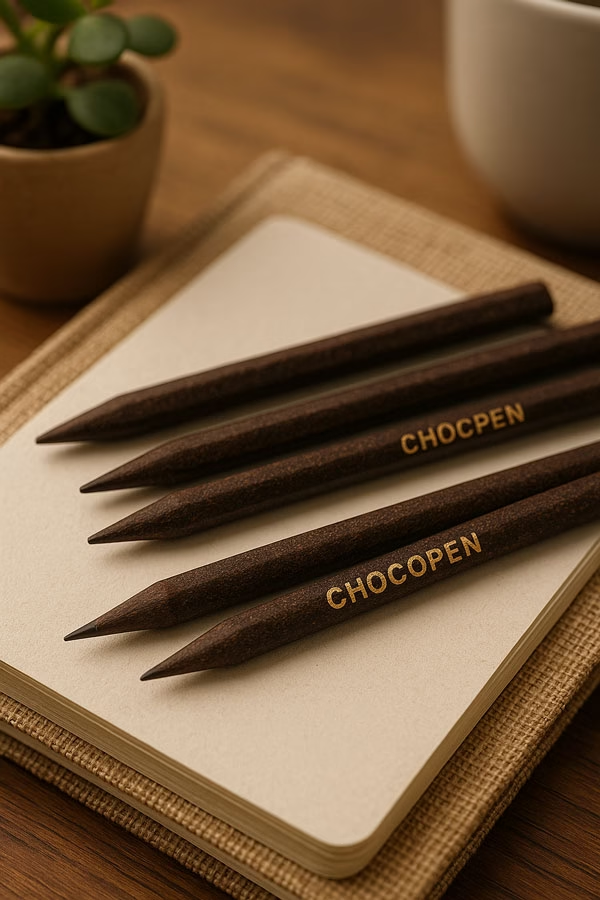
CHOCOPENの魅力は、なんといってもその独創的なデザインにあります。
- 色と質感:色は、チョコレートを思わせる、深みのあるダークブラウン。表面は少しザラッとしていて、プラスチックや木とは全く違う、自然素材ならではの温かみのある手触りがします。カカオの殻の繊維がそのまま見えるので、一本一本、表情が微妙に違うのも魅力的です。
- ロゴ:鉛筆の軸には、「CHOCOPEN」と「MITSUBISHI PENCIL 9800」のロゴが、ゴールドで上品に刻印されています。この「9800」という数字、実は三菱鉛筆が長年販売している事務用鉛筆の定番モデルの品番なんです。歴史あるモデルの品番をあえて入れることで、品質への自信と、このプロジェクトにかける三菱鉛筆の本気度が伝わってきますね。
- 香り:SNSなどの口コミを見ていると、「ほんのり甘い、カカオの香りがする」という声も。嗅覚でも、チョコレートとの繋がりを感じられるなんて、素敵ですよね。
ただの「書く道具」としてだけでなく、デスクに置いておくだけで、ちょっとしたオブジェのように空間を彩ってくれる。そんなデザイン性の高さも、CHOCOPENが多くの人を惹きつける理由の一つです。
書き心地
「デザインは素敵だけど、鉛筆としてちゃんと使えるの?」
そこ、気になりますよね。ご安心ください。そこは、世界の三菱鉛筆です。
口コミでは、
「見た目の印象より、しっかりとした硬さがある」
「普通の鉛筆と変わらない、なめらかな書き心地」
といった声が多く見られました。
カカオの殻を70%以上も使用しているにもかかわらず、文房具としての品質に一切妥協しない。開発の苦労話を知った後だと、この「当たり前に使える」ということが、いかにすごいことか分かります。
受賞歴
そのストーリー性と、革新的なアイデア、そして製品としての完成度の高さは、外部からも高く評価されています。
なんと、発売後すぐに「第34回 日本文具大賞 2025」のサステナブル部門で、優秀賞を受賞しました。
これは、文具業界のプロたちがその年の優れた製品を選ぶ、とても権威のある賞です。CHOCOPENが、デザインや想いだけでなく、文房具としても一級品であることが証明されたと言えますね。
どこで買える?CHOCOPENの購入方法
「CHOCOPEN、ぜひ手に入れてみたい!」
そう思ってくださった方のために、現在の購入方法をまとめてみました。
オンラインストア
遠方にお住まいの方や、お店に行く時間がないという方でも、オンラインで手軽に購入できます。
- CLOUDY公式オンラインストアCHOCOPENはもちろん、CLOUDYが展開するアフリカンテキスタイルを使ったカラフルでおしゃれなアパレルや雑貨も一緒に見ることができます。見ているだけでも元気になるサイトなので、ぜひ一度覗いてみてください。
店舗
実際に手に取って、その質感や色合いを確かめたいという方は、ぜひ店舗に足を運んでみてください。
- CLOUDY ハラカド店2024年4月に、東急プラザ原宿「ハラカド」内にオープンしたCLOUDYのフラッグシップストアです。CHOCOPENだけでなく、CLOUDYの世界観を存分に体感できる空間になっています。お買い物がてら、立ち寄ってみるのも楽しそうですね。
現在は、主にCLOUDYの直営店やオンラインストアでの販売が中心のようです。
今後、取り扱い店舗が増えていく可能性もあるので、気になる方は公式サイトをチェックしてみてくださいね。
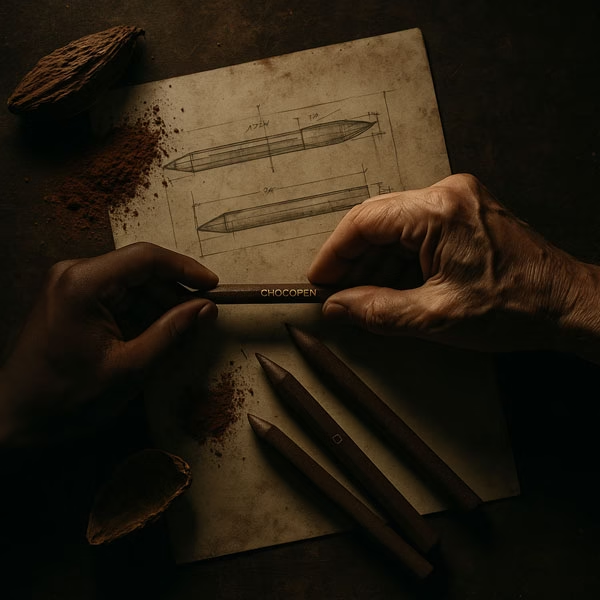
まとめ:CHOCOPENを選ぶということ – 日常の選択が、世界を変える一歩になる
ここまで、CHOCOPENの物語を一緒に旅してきましたが、いかがでしたでしょうか。
一本の鉛筆。
それは、私たちの日常に当たり前にある、とても小さな存在です。
でも、CHOCOPENは、その小さな一本の向こう側に、ガーナの広大なカカオ畑や、そこで働く人々の笑顔、そして鉛筆を手に喜ぶ子どもたちの未来が、確かに繋がっていることを教えてくれます。
私たちがCHOCOPENを選ぶこと。
それは、単に「物を買う」という消費行動ではありません。
- 環境問題の解決に参加するという「意思表示」。
- 持続可能な社会を応援するという「投票」。
- 遠い国の誰かと繋がるという「体験」。
そんな、たくさんの意味が込められた、とてもポジティブなアクションなんです。
「社会貢献」と聞くと、なんだか難しくて、自分には縁遠いもののように感じてしまうかもしれません。
でも、本当はそんなことなくて。
毎日飲むコーヒーをフェアトレードのものに変えてみたり、エコバッグを持ち歩いたりするのと同じように、いつもの鉛筆をCHOCOPENに変えてみる。
そんな、日常の中のちょっとした選択の積み重ねが、世界を少しずつ、でも確実に良い方向へ動かしていく力になる。CHOCOPENは、そのことを静かに、でも力強く、私たちに語りかけてくれているような気がします。
もしあなたが、この記事を読んで、少しでも心が動かされたなら、ぜひ一度、CHOCOPENを手に取ってみてください。
カカオの殻の温かい手触りを感じながら、地球の裏側にいるあなたの「相棒」に、想いを馳せてみてはいかがでしょうか。
その小さな一本が、あなたの明日を、そして世界の明日を、ほんの少しだけ豊かに彩ってくれるはずです。
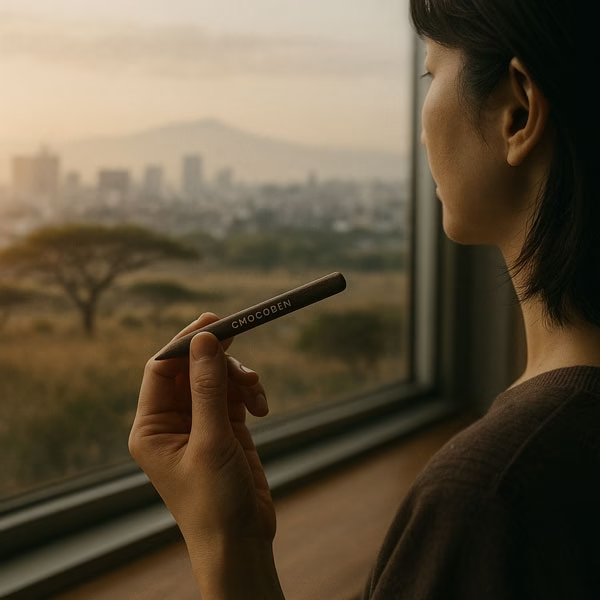
English Version is as follows
Everything You Need to Know About CHOCOPEN: The Story of a Sustainable Pencil Born from Mitsubishi Pencil and Cacao Husks
Introduction: What is CHOCOPEN? – An Earth- and People-Friendly Pencil Born from Chocolate
Hello!
When you’re on a break from work or just need a moment to relax, a sweet piece of chocolate can be so comforting, can’t it? I admit, I always keep some stashed in my desk drawer.
But what if the process of making that chocolate created a lot of “waste”? And what if that “waste” was threatening the environment and the health of people in a faraway country? Doesn’t that make your heart ache just a little?
“I wonder if there’s something I can do…”
“But I don’t know if I can do anything big…”
If you’re a kind person who feels this way, there’s a single pencil I truly want you to know about.
It’s called the “CHOCOPEN.”
This isn’t just any ordinary pencil.
Amazingly, it’s made from the “cacao husks”—the shells left behind after the beans are taken from the pods of the cacao plant, the very source of our beloved chocolate.
These are husks that would otherwise have been mostly thrown away.
But through a meeting of technology from the veteran Japanese stationery maker “Mitsubishi Pencil” and the passionate vision of the “NPO CLOUDY,” which works in Ghana, Africa, they have been reborn into this wonderful pencil.
And there’s an even more heartwarming story hidden within the CHOCOPEN.
It’s a charity system where “for every one you buy, one is given to a child in Ghana.”
In this article, I’ll explore:
- The story behind the chocolate that led to CHOCOPEN’s creation.
- How choosing a CHOCOPEN connects us to social contribution.
- The behind-the-scenes story of how this unprecedented pencil was developed.
- Details on its design, price, and where you can get one.
…and much more, covering all the charms of the CHOCOPEN.
By the time you finish reading, I’m sure you’ll find this small pencil incredibly precious.
Our small action of “choosing” can become a big step toward making the world a little better. Shall we unravel this wonderful story together?
Why Cacao Husks? The Social Problems CHOCOPEN is Solving in Ghana
“Making a pencil from cacao husks? What a fascinating idea!”
That’s a natural reaction. But this project actually began from a much more serious awareness of a problem.
First, let me tell you a little about the social issues in Ghana that CHOCOPEN aims to solve.
The Challenge Behind Chocolate: Massive Amounts of Discarded Cacao Husks
For many of us in Japan, Ghana brings to mind “Ghana Chocolate.” True to that image, Ghana is one of the world’s leading cacao producers. The cacao industry is a vital pillar supporting the nation’s economy.
However, behind the scenes, the massive amount of “cacao husks” left after the harvest has been a major, long-standing problem.
The ingredient for chocolate is only the “cacao bean” inside the pod. In fact, about 90% of the cacao pod’s weight is the husk, pulp, and other parts besides the bean. To put it another way, for every 100g of chocolate we eat, nearly 1kg of husks is generated behind the scenes.
Considering the world’s annual cacao bean production is about 5 million tons, you can imagine the staggering amount of husks produced each year.
For years, farmers have struggled with how to dispose of these massive quantities of husks.
While some are reused as fertilizer, most are simply piled up on the edges of fields or in villages.
And these piles of discarded husks create various problems.
Environmental and Health Problems Caused by Cacao Husks
| Problem | Specific Details |
| Soil Degradation | Cacao husks have high acidity. When left in large quantities, they can alter the soil’s properties, causing “soil degradation” that makes it difficult for other crops to grow. It’s tragic that the cacao farmers’ own fields lose their vitality. |
| Pest Outbreaks | As the husks decompose, they can become a breeding ground for insects that harm crops. |
| Foul Odors | The decomposition of massive piles of husks generates strong odors, worsening the living environment in villages. |
| Breeding Ground for Malaria Mosquitoes | This is one of the most serious issues. Rainwater collects in the hollows of the cacao husks, creating a perfect breeding ground for the mosquitoes that transmit the infectious disease “malaria.” |
The malaria problem is especially severe.
According to the World Health Organization (WHO), Ghana is one of the 11 countries with the highest malaria burden in the world. In 2022, there were an estimated 5.3 million cases and 12,500 deaths.
Many of these victims are children under five with weaker immune systems.
The thought that the chocolate we eat might be putting children in a distant country at risk is hard to ignore, isn’t it?
From ‘Waste’ to ‘Resource’: The Change CHOCOPEN Brings
“Couldn’t we somehow turn these troublesome cacao husks into something of value?”
This question was the starting point for the CHOCOPEN project.
Have you heard the term “upcycling” recently?
It’s a bit different from “recycling.” Upcycling is about giving new value to things that would have been thrown away, through design and ideas, transforming them into something even better.
CHOCOPEN is the very embodiment of this upcycling concept.
It transforms cacao husks—once treated as “waste” and causing environmental and health problems—into a product with entirely new value: a “pencil.”
But the brilliance of this project doesn’t stop there.
By building the pencil factory in Ghana, it has created new “employment” opportunities locally. Farmers can earn income by selling husks they used to discard, and factory workers can get stable jobs.
In other words, CHOCOPEN brings about two major changes in Ghana:
- It solves environmental problems (reducing waste, suppressing malaria mosquito breeding grounds).
- It creates new industry and employment (supporting economic independence).
‘FOR MY BUDDY’ – Your Purchase Helps Draw a Future for Ghana
The appeal of CHOCOPEN goes beyond its environmental and economic contributions.
This pencil has a heartwarming system where our individual act of “buying” is directly connected to the future of children in Ghana.
CHOCOPEN’s Unique Charity
Take a close look at the CHOCOPEN packaging.
Doesn’t it seem a bit unusual?
It’s a cylindrical case that looks like it could hold two pencils, but there’s only one inside.
And in the empty space, there’s a message:
“FOR MY BUDDY”
A “buddy” is a partner or a friend.
That’s right, this empty space is for your “buddy” in Ghana.
When we buy one CHOCOPEN, another one is delivered to a child in Ghana.
This packaging is proof of that promise. The moment you hold it, you feel a connection to an unseen “buddy” in a faraway country. It’s a truly wonderful design.
“But why donate stationery?” you might wonder.
In Ghana, where the NPO CLOUDY operates, many children cannot afford enough school supplies, even if they can attend school. Without notebooks or pencils, they can’t take notes in class or practice reading and writing. They have the desire to learn, but not the tools.
A single pencil.
For us, it might be something we can get easily.
But for the children of Ghana, it can be an irreplaceable “wing” to draw their dreams and carve out their future.
Our single action of choosing a CHOCOPEN.
It could lead to learning for our “buddy” on the other side of the planet, and it might become a light that brightens that child’s future. When you think about it that way, it warms your heart, doesn’t it?
A Model for Sustainable Support
When we hear “donation,” we might just imagine sending goods.
While that is a noble act, what makes the CHOCOPEN system a step ahead is that it’s a model of “sustainable support.”
There’s a famous saying: “Give a man a fish, and you feed him for a day. Teach a man to fish, and you feed him for a lifetime.”
The CHOCOPEN project embodies this philosophy.
It has created a cycle where:
- Pencils are made in Ghana, using Ghanaian resources (cacao husks).
- By the hands of Ghanaian people (creating employment).
- And a portion of the profits supports the education of Ghanaian children.
Instead of relying on external aid, it helps local people solve their own problems, drive their economy, and nurture their future.
CHOCOPEN is a project that builds this path to “self-reliance” together.
The 330 yen we pay includes not just the price of the product, but also an investment in this sustainable future. Thinking of it that way makes this single pencil feel even more valuable.
The Development Story: Overcoming Challenges with Mitsubishi Pencil’s Technology and CLOUDY’s Passion
While CHOCOPEN has such a wonderful story, the journey to its creation was anything but smooth.
The unprecedented challenge of “making a pencil from cacao husks” was fraught with difficulties.
Let’s take a peek behind the scenes at the development that brought CHOCOPEN to us.
The Project’s Beginning
This story began with the meeting of two individuals.
One is Mr. Yuto Doya, the representative director of NPO CLOUDY. Shocked by the situation in Africa he witnessed as a university student, he founded CLOUDY after graduating. He is a passionate individual who has dedicated his life to creating employment, education, and health support in Africa under the philosophy of “clearing up the cloudy days.”
As Mr. Doya pondered what could be done about the problematic cacao husks in Ghana, he hit upon the idea: “Could Japanese technology transform this into something of value?”
The person he approached was the other key figure:
Mr. Shigehiko Suhara, the president of Mitsubishi Pencil Co., Ltd., a company with over 130 years of history.
Mr. Doya brought his passionate vision and a bag of cacao husks from Ghana.
Normally, it would be no surprise to be turned away with a “this isn’t our business.” It was an unknown challenge with no guarantee of profit.
However, President Suhara reportedly responded on the spot, “This sounds interesting. Let’s do it.”
Mitsubishi Pencil’s long-held philosophy, “The best quality is the best service,” was not just about making good products, but also a desire to use its technology for the good of society.
This miraculous project was quietly born at the moment when the desires of both organizations—to contribute to solving social issues, not just pursue corporate profit—aligned.
An Unprecedented Challenge: Behind the Scenes of Development
However, deciding to “do it” was just the beginning of the real battle.
The development team was confronted by a material that was utterly unknown and temperamental: the “cacao husk.”
“Cacao husks are actually very difficult to work with,” says a developer.
They were completely different from the “wood” normally used for pencil barrels.
The Three Walls of Cacao Husks That Stumped the Development Team
- Wall #1: It Won’t Stick Together!Even when ground into a powder, the cacao husks were fibrous and crumbly. When they tried to form it into a pencil shape, it would immediately fall apart. It was apparently like trying to make cookie dough that just won’t come together.
- Wall #2: Not Strong Enough!Even if they managed to solidify it, it lacked strength. It would crumble when sharpened or snap in the middle of writing. This made it unusable as a writing instrument.
- Wall #3: It Bends!Cacao husks easily absorb moisture and shrink significantly when dried. This meant that even if they made a straight pencil, it would warp or bend during the drying process. Maintaining consistent quality was extremely difficult.
Development was a continuous process of trial and error.
They adjusted the husk grinding method by the millimeter and tested dozens of types and blends of resin binders. At times, a sentiment of “this might be impossible” reportedly spread through the team.
But they didn’t give up.
This is where Mitsubishi Pencil’s world-class technological prowess came into play.
In particular, the technology for making pencil “lead” provided a major clue to overcoming this hurdle.
Pencil lead is made by mixing two completely different materials, graphite and clay, very uniformly. This know-how of “mixing different things uniformly” was brilliantly applied to the process of mixing cacao husks and resin.
The deep understanding of materials cultivated over 130 years with brands like “uni,” and a spirit of uncompromising craftsmanship. And the passionate desire of CLOUDY “for the children of Africa.”
When these two forces combined, a miracle finally happened.
The world’s first “pencil made from cacao husks,” boasting sufficient strength and a smooth writing feel, was completed.
The project took about two years to bring to fruition.
Behind a single CHOCOPEN lies this story of the developers’ incredible effort and passion.
Product Information: Getting to Know CHOCOPEN
Now that you know the deep story behind CHOCOPEN, you must be getting curious about the pencil itself.
“What’s the design like?” “How does it write?” “How much does it cost?”
Let’s answer these questions one by one!
Price
The price of one CHOCOPEN is 330 yen (tax included).
This price includes:
- The cost of the product itself.
- The costs for creating employment and environmental maintenance in Ghana.
- The donation to deliver a pencil to a child in Ghana.
It might seem a little more expensive than a regular pencil. But when you consider the story behind this single pencil and the future it helps create, you could see it as “social contribution you can participate in for 330 yen.”
It’s a perfect price for a small treat for yourself or a simple gift for a dear friend, isn’t it?
Design
The charm of CHOCOPEN lies in its unique design.
- Color and Texture: The color is a deep, rich dark brown, reminiscent of chocolate. The surface is slightly rough, giving it a warm, natural feel completely different from plastic or wood. You can see the fibers of the cacao husks, meaning each pencil has a slightly different expression, which is part of its appeal.
- Logo: The barrel is elegantly stamped in gold with the “CHOCOPEN” and “MITSUBISHI PENCIL 9800” logos. This “9800” number is actually the model number of a classic office pencil that Mitsubishi Pencil has been selling for many years. By intentionally using the part number of a historic model, they convey their confidence in the quality and their serious commitment to this project.
- Scent: Looking at comments on social media, some people say it has “a faint, sweet cacao scent.” To be able to feel the connection to chocolate through smell is wonderful, isn’t it?
It’s not just a “tool for writing,” but something that can adorn your desk space like a small art object. This high level of design is another reason CHOCOPEN attracts so many people.
Writing Feel
“The design is lovely, but does it work properly as a pencil?”
That’s a valid concern. Rest assured, this is Mitsubishi Pencil we’re talking about.
Online reviews often mention:
“It has a sturdier, harder feel than it looks.”
“It writes as smoothly as a regular pencil.”
Despite using over 70% cacao husks, there is no compromise on its quality as a writing instrument. After learning about the development struggles, you realize just how incredible this “usable as normal” quality is.
Awards
Its story, innovative idea, and the perfection of the product have been highly praised externally.
Amazingly, it won an Award for Excellence in the Sustainable category at the 34th Japan Stationery Awards 2025 shortly after its release.
This is a very prestigious award where stationery industry professionals select the year’s best products. It proves that CHOCOPEN is a top-tier product not just in its design and mission, but also as a piece of stationery.
Where to Buy: How to Get a CHOCOPEN
For those of you thinking, “I’d love to get a CHOCOPEN!” here is a summary of the current purchasing options.
Online Store
Even if you live far away or don’t have time to go to a store, you can easily buy it online.
- CLOUDY Official Online StoreYou can see not only CHOCOPEN but also the colorful and stylish apparel and goods made with African textiles that CLOUDY develops. The site is a joy just to browse, so please take a look.
Retail Stores
If you want to actually hold it in your hand and see its texture and color, please visit a store.
- CLOUDY Harakado StoreThis is CLOUDY’s flagship store, which opened in April 2024 inside Tokyu Plaza Harajuku “Harakado.” It’s a space where you can fully experience the world of CLOUDY, not just CHOCOPEN. It would be fun to stop by while you’re out shopping.
Currently, sales are mainly centered around CLOUDY’s direct stores and online store.
It’s possible that more retailers will carry it in the future, so if you’re interested, please check the official website.
Conclusion: Choosing CHOCOPEN – How Everyday Choices Can Become a Step to Change the World
We’ve journeyed through the story of CHOCOPEN together. What did you think?
A single pencil.
It’s a very small, ordinary part of our daily lives.
But CHOCOPEN teaches us that beyond this small pencil, there is a definite connection to the vast cacao fields of Ghana, the smiles of the people working there, and the future of the children who receive these pencils with joy.
When we choose CHOCOPEN,
it’s not just a consumer act of “buying something.”
It’s “a statement of intent” to participate in solving environmental problems.
It’s “a vote” to support a sustainable society.
It’s “an experience” that connects us with someone in a faraway country.
It’s a very positive action filled with so much meaning.
“Social contribution” might sound difficult or distant.
But it doesn’t have to be.
Just like choosing fair-trade coffee or carrying an eco-bag, you can switch your usual pencil to a CHOCOPEN.
The accumulation of these small, everyday choices has the power to move the world in a better direction, slowly but surely. It feels like CHOCOPEN is quietly but powerfully telling us this.
If this article has moved you, even just a little, I hope you’ll pick up a CHOCOPEN once.
As you feel the warm texture of the cacao husks, why not let your thoughts drift to your “buddy” on the other side of the world?
That one small pencil is sure to enrich your tomorrow, and the world’s tomorrow, just a little bit more.
